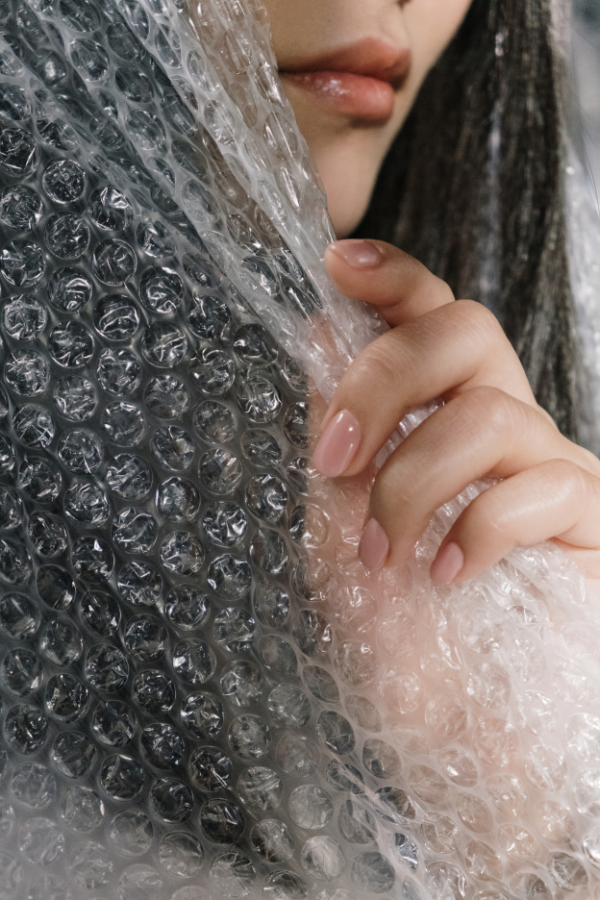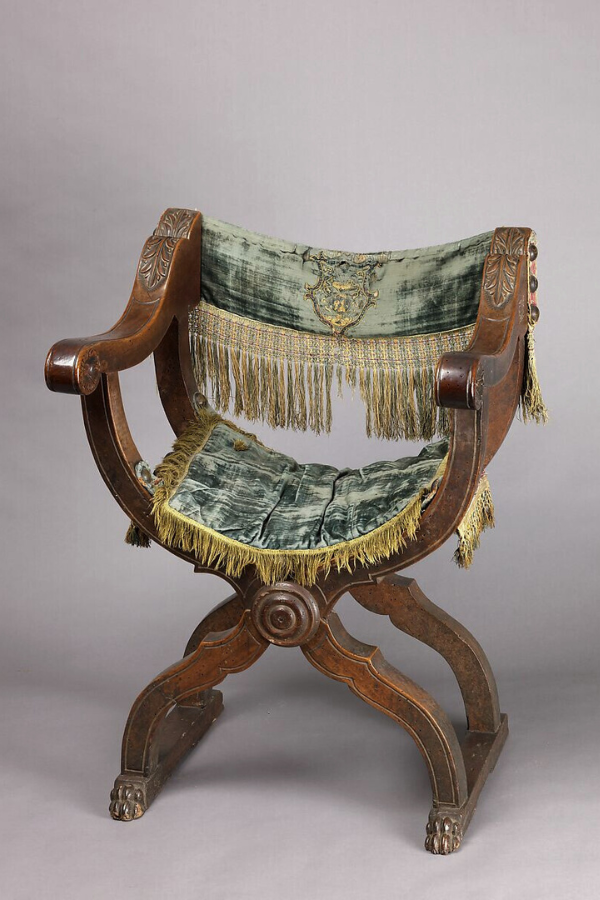
DesignDash Guide: How to Safely Store Off-Season Clothing
Summary
Storing your off-season clothing thoughtfully not only preserves your favorite pieces but also helps clear space for new inspiration and creativity. With the right storage solutions, like breathable garment bags, proper sorting techniques, and eco-conscious practices, you can ensure your clothes stay in great condition for years to come. This guide offers practical tips for organizing your wardrobe with care, making seasonal transitions easier, and allowing more mental space for what truly matters.
Reflection Questions
- How does having an organized wardrobe impact your ability to focus on other creative projects or life goals?
- Are there specific clothing items that hold sentimental value for you? How can you best care for them so they last longer?
- In what ways could you design your storage system to reflect your personal style and bring more joy to the process of organizing?
Journal Prompt
Reflect on the connection between your physical space and mental clarity. How does organizing your wardrobe help you feel more at ease or inspire new ideas? Write about a time when clearing your space allowed you to welcome new opportunities or experiences into your life, and set an intention for how you want to use the space you create this season.
Our lives are busy enough without seasonal organizing, aren’t they? However, the art of organizing—especially when it comes to storing off-season clothing—can be an act of letting go. It enables you to make space not only in your home but also in your mind. Clearing your physical space allows new creative energy to flow, giving you more room to focus on what truly matters. And when done thoughtfully, proper storage extends the life of your favorite pieces. If you observe an eco-conscious lifestyle, storing seasonal clothing is absolutely essential! Here’s how to store seasonal clothes with care and intention so you can enjoy them for years to come—without cluttering your closet (or your brain). Don’t forget to download our seasonal clothing storage checklist at the end of this article!
Why Proper Seasonal Clothing Storage Matters

Clothing isn’t just functional. We all know that it carries memories and emotions. Whether it’s a dress you wore on a special trip, a cozy sweater that got you through long workdays, or winter coats passed down through generations, these items deserve care. Storing clothes properly allows you to revisit these moments without worry, ensuring they remain a part of your life for years to come.
Preserving your clothing from damage—like moths, moisture, and wrinkles—is not just about organization; it’s about protecting the investment you’ve made in quality pieces. Taking a few simple steps to ensure your favorite items stay in good condition means less waste, fewer replacements, and more opportunities to cherish what you already own.
In a way, caring for your wardrobe is an extension of caring for yourself. When we take the time to preserve the things we love, we make room for more ease and creativity in our lives. Just as we nurture our ideas, projects, and relationships, keeping our clothes in good shape reflects a thoughtful and intentional approach to living.
Top Tip for Clothing Care: Always clean your clothes before storing them to prevent stains from setting in and to avoid attracting pests. A quick wash or trip to the dry cleaner now can save you from unpleasant surprises later!
A Brief Overview of Fabrics and Fibers You Shouldn’t Store Together
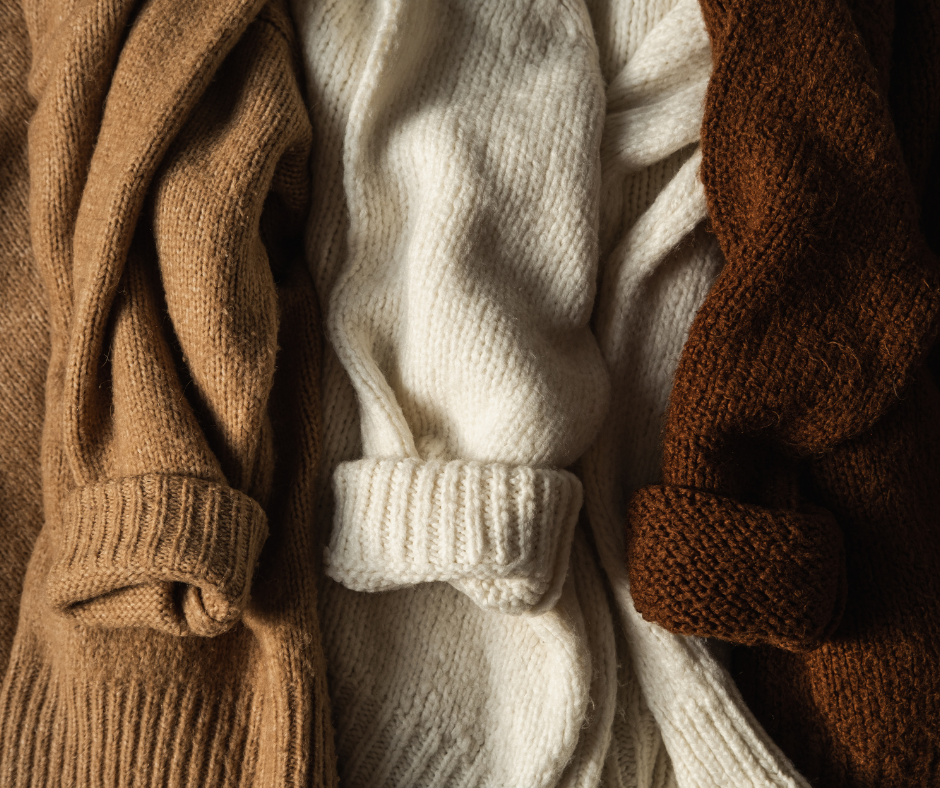
When you store clothes, it’s important to remember that different fabrics have different needs. For example, wool and delicate fabrics like silk and lace should never be stored together. Wool can shed fibers and release oils, which may stain delicate pieces. Instead, store wool items in breathable fabric bags to protect both fabric types from damage.
Likewise, natural fibers such as cotton and linen need to breathe, while synthetic fibers like polyester and nylon can handle being sealed up tight. Synthetic fabrics tend to cause static and can cling to natural fibers, so it’s best to keep them apart. Use breathable bags for natural fibers and sealed bins for synthetics to maintain quality.
Leather and suede need special care. These materials need proper air circulation to avoid cracking and can transfer oils to other fabrics. Storing leather and suede in cloth garment bags, away from other clothing, is the best way to protect them and everything else.
Hurry to save an extra 25% on selected clearance styles, now through October 14 at Nordstrom!
When storing heavy and lightweight fabrics, keep in mind that heavy items like denim or thick wool can crush lighter, delicate fabrics like chiffon. Store heavier fabrics on shelves or folded at the bottom, and keep your lighter items higher up or hanging in garment bags.
Knitwear and embellished items with sequins or beading should also be kept apart. Knitwear can snag on embellishments, leading to damage. Fold knitwear neatly in breathable bags and wrap embellished items separately with tissue paper for protection.
Finally, fur needs its own space. It sheds and releases oils that can affect other fabrics, and it requires proper airflow to stay in good condition. Store fur in cloth garment bags that allow it to breathe.
General Storage Tips: For natural fibers, breathability is key, so avoid sealing them in plastic bags. Synthetics can be stored in airtight containers without issue. For added protection, use tissue paper or cotton sheets to separate different fabrics within storage bins.
The DesignDash Guide to Seasonal Clothing Storage
Step 1: Sorting Your Wardrobe
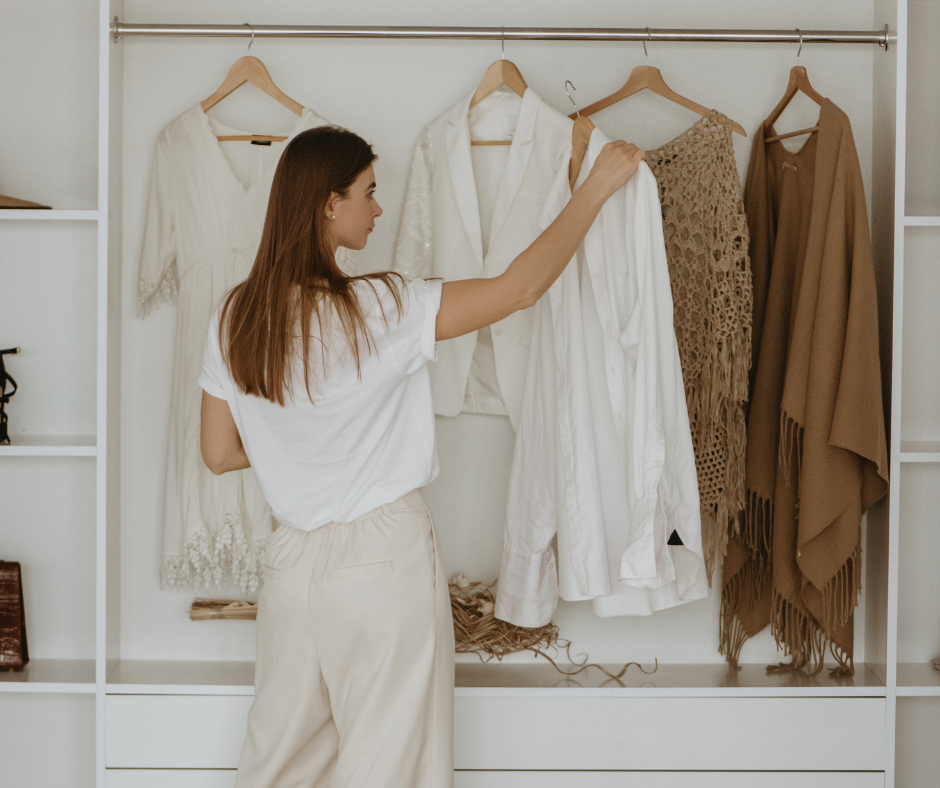
Before you pack any off-season clothes away, let’s talk about how to sort them. Sorting your wardrobe doesn’t have to feel overwhelming—it can actually be a refreshing way to reset! Start by pulling everything out and assessing each piece. Ask yourself: Do I love it? Does it fit my current lifestyle? Is it in good condition? Items that no longer serve you can be donated, upcycled, or recycled, freeing up valuable space and energy. The goal is to keep only what you truly love or need for the next season.
Editing your wardrobe can actually spark creativity. When you have fewer items to choose from, you minimize decision fatigue and open up mental space for inspiration to flow. You’ll find that getting dressed, whether for work or travel, becomes easier and more joyful when you’re surrounded by pieces that reflect your personal style.
By making space in your wardrobe, you’re also making space for new inspirations and experiences. Keeping your beloved pieces safe and organized means they’ll be ready when the season changes. Clearing out what no longer works for you creates room for fresh energy and creativity in your life.
Top Tip for a Streamlined Wardrobe: Sort clothing by fabric type, function, and frequency of wear before storing. This makes it easier to find what you need next season and helps you stay organized with minimal effort!
Step 2: Selecting Appropriate Storage Solutions
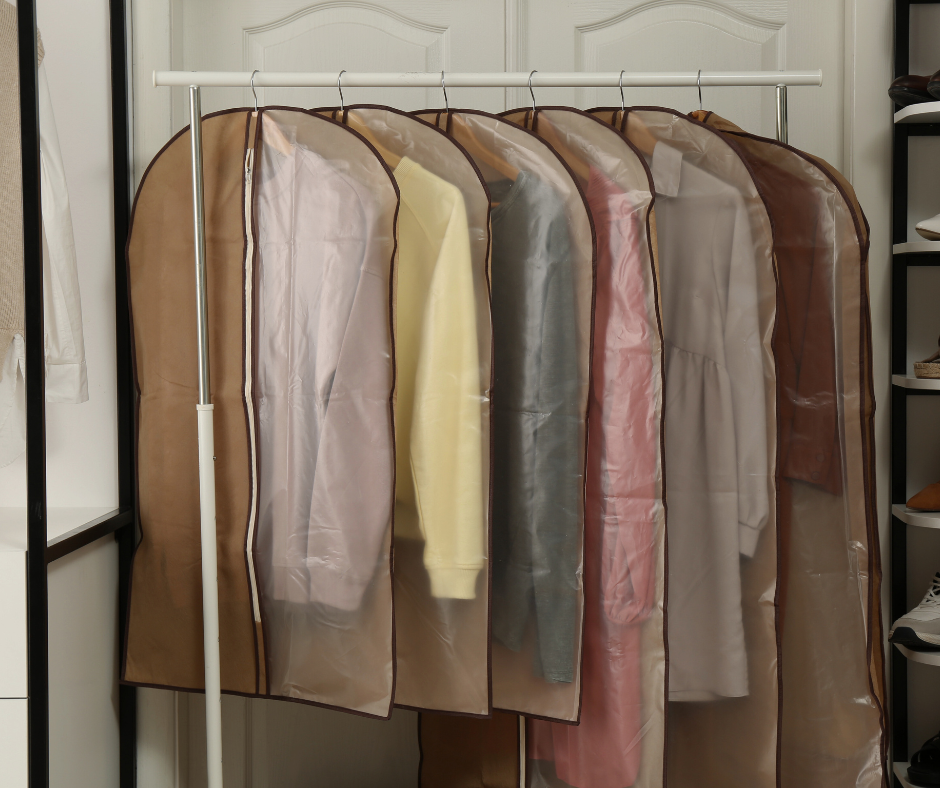
Choosing the right storage solutions can make all the difference when it comes to preserving your off-season clothing and freeing up closet space. Breathable garment bags are ideal for delicate fabrics, while vacuum-sealed bags are perfect for bulky items like coats and sweaters that need to save space. If using garment bags, be sure to avoid wire hangers that can snag delicate fabrics. Plastic bins with lids offer protection from dust and pests, and adding cedar blocks can help naturally deter moths and keep your clothing smelling fresh.
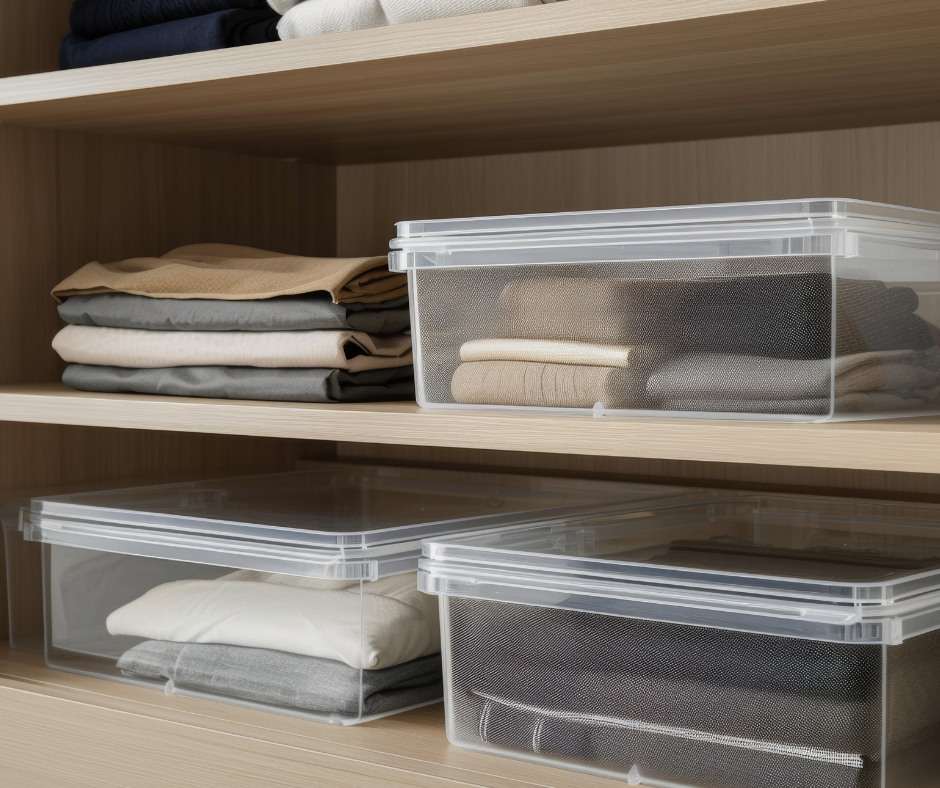
Where possible, opt for sustainable materials like cotton garment bags, cardboard boxes, or recycled plastic storage containers to reduce waste, save storage space, and keep your storage eco-friendly. Being mindful of the materials you use not only benefits the environment but also helps protect your clothing from harmful chemicals.
To keep your clothing fresh and protected from environmental factors, it’s important to store items in a cool, dry place away from direct sunlight. Using moisture-absorbing materials such as silica gel packs or cedar blocks can be especially helpful in humid climates.
Top Tip for Choosing Storage: Select storage containers that match your climate needs—if you live in a humid area, make sure to include moisture-absorbing materials to prevent mildew and keep your clothes in perfect condition!
Step 3: Observe Best Practices for Long-Term Clothes Storage

When prepping your storage space for the long term, it’s important to choose a climate-controlled area that is cool, dark, and dry. Avoid areas with fluctuating temperatures or excess moisture, like basements or attics, as these can lead to damage over time. Keeping your clothing in a stable environment will help preserve its quality and prevent unwanted surprises when the seasons change.
To maintain your wardrobe’s condition, make a habit of rotating and inspecting your stored items every few months. This allows you to check for any signs of damage, like pests or moisture, and keep everything fresh and ready to wear. It also gives you a chance to reassess your collection and let go of anything you no longer need.
A well-organized wardrobe protects your favorite pieces and simplifies seasonal transitions. Storing your clothes thoughtfully creates a sense of order that frees up mental energy for more creative pursuits. When your closet is in harmony, your mind often follows, allowing for smoother shifts between seasons and life moments.
Top Tip for Long-Term Success: Add lavender sachets or cedar balls to your storage containers to naturally deter pests and keep your clothes smelling fresh and clean for the next season!
Step 4: Organize with Intention

Organizing your off-season wardrobe can be more than just a chore—it’s an opportunity to create a storage system that reflects your personal style and lifestyle. Think of it as an extension of your creativity, where practicality meets beauty. Whether you prefer minimalist designs or something more playful, your storage solution can be as inspiring as the clothes themselves.
Consider labeling your storage bins or garment bags in creative ways that match your aesthetic. You could use elegant calligraphy, colorful tags, or even personalized stickers to give your system a stylish touch. It’s these little details that can make organization feel more intentional and enjoyable.
Fuel your creative fire & be a part of a supportive community that values how you love to live.
subscribe to our newsletter
*please check your Spam folder for the latest DesignDash Magazine issue immediately after subscription

There’s something special about making even functional spaces beautiful. It transforms an everyday task into a mindful practice, helping you find balance in your busy life. By designing an organized, visually pleasing system, you bring a sense of harmony to your home that extends beyond the closet.
Top Tip for Aesthetic Organization: Opt for clear, stackable storage bins—they make it easy to see what you’ve stored and create a clean, cohesive look that’s both functional and visually appealing!
Step 5: Take Clothes Out of Long-Term Storage and Assess Them

Taking your clothes out of storage is just as important as putting them away. When the new season arrives, start by carefully unpacking your stored items and laying them out in a clean space. Look for any signs of damage—like fading, wrinkles, or mustiness—that might have occurred during storage. If you notice any issues, address them promptly by airing out the items or giving them a wash.
It’s also a great time to reassess each piece and decide whether it still fits your style or lifestyle. As you unpack, ask yourself if the item still sparks joy or if it’s time to donate or upcycle it. This process helps keep your wardrobe fresh and aligned with your current needs.
Once you’ve inspected everything, give the items some air to freshen them up before folding or hanging them back in your closet. This is also an opportunity to reintroduce your favorite pieces with intention, ensuring they’re ready to wear when you need them.
Top Tip for Assessing Clothes: After removing clothes from storage, give them a quick steam or light wash to freshen them up and remove any wrinkles before adding them back into your wardrobe rotation.
Final Thoughts: Clearing Space for What’s Next
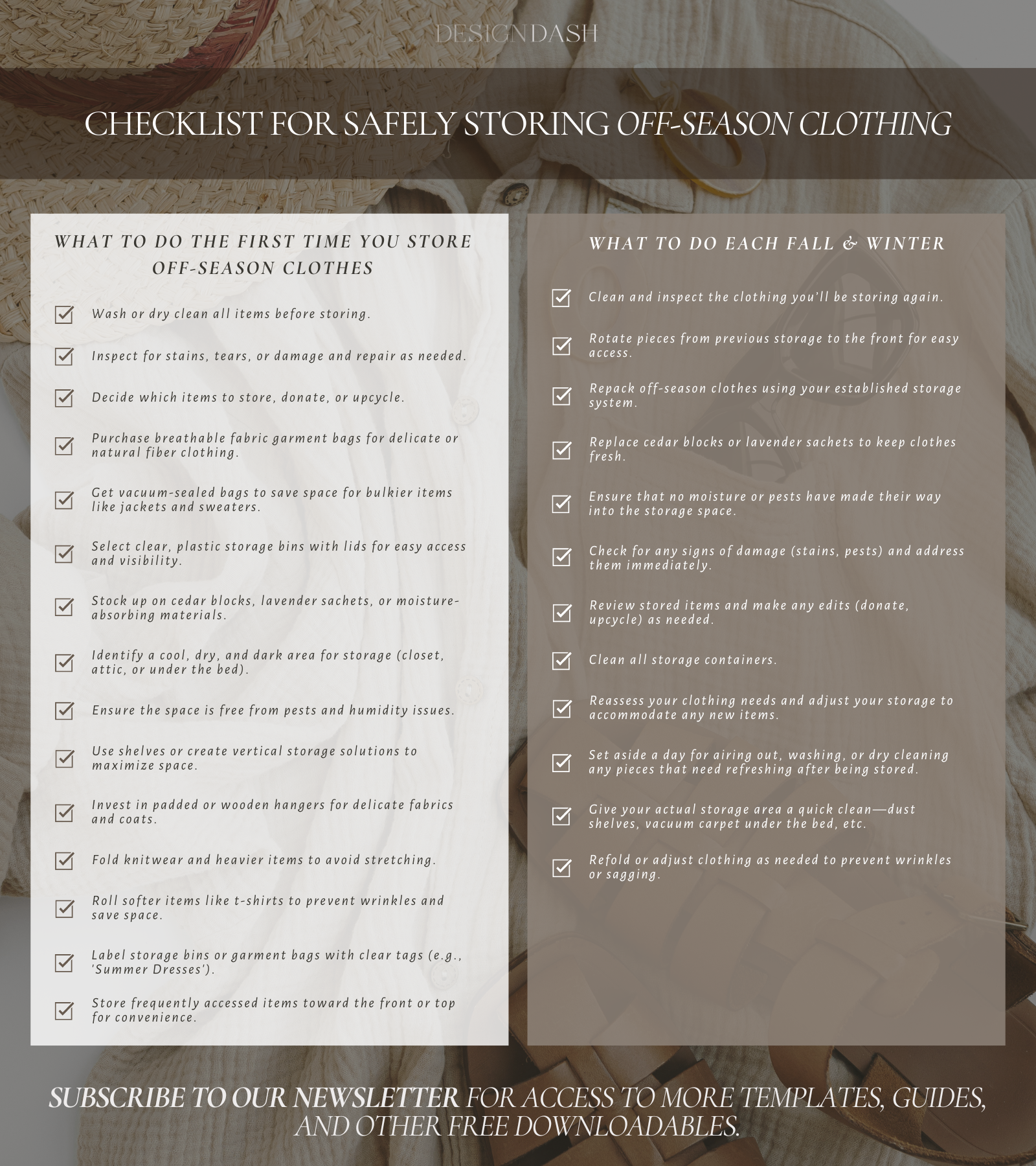
Mindfully storing your off-season clothes isn’t just about organization—it’s about preparing yourself for the next chapter of your life. Whether you’re gearing up for a new season of travel, family time, or exciting creative projects, having a well-kept wardrobe allows you to focus on what truly matters. Keeping your clothing in order creates space for inspiration, new ideas, and opportunities to flow into your life with ease.
As you transition into the next season, remember that your wardrobe is just one part of the bigger picture. Organizing it thoughtfully can clear the mental clutter and make room for the things that spark joy and creativity.
Top Tip for a Fresh Start: After storing your off-season clothes, take a moment to reflect on what’s ahead—set intentions for the creative projects and personal moments you want to nurture in the upcoming season. And don’t forget to download our checklist!





